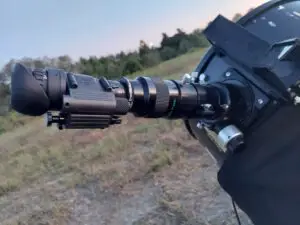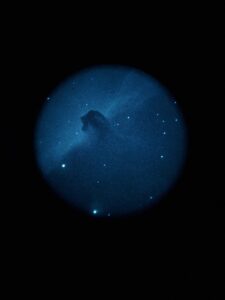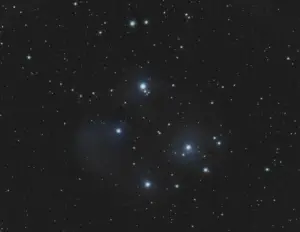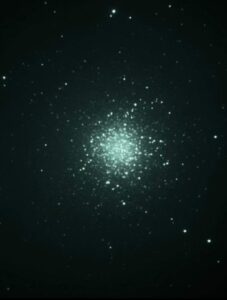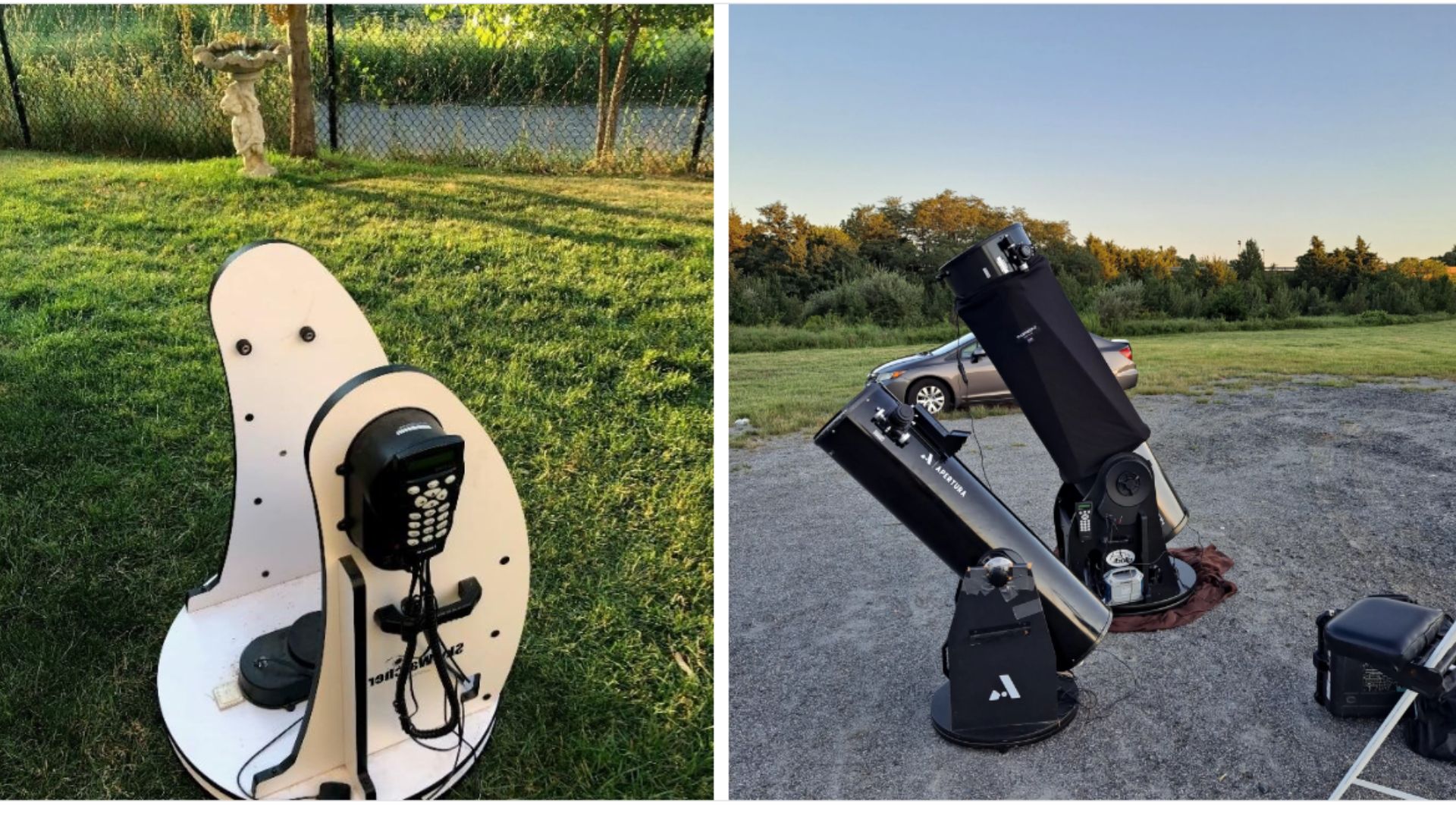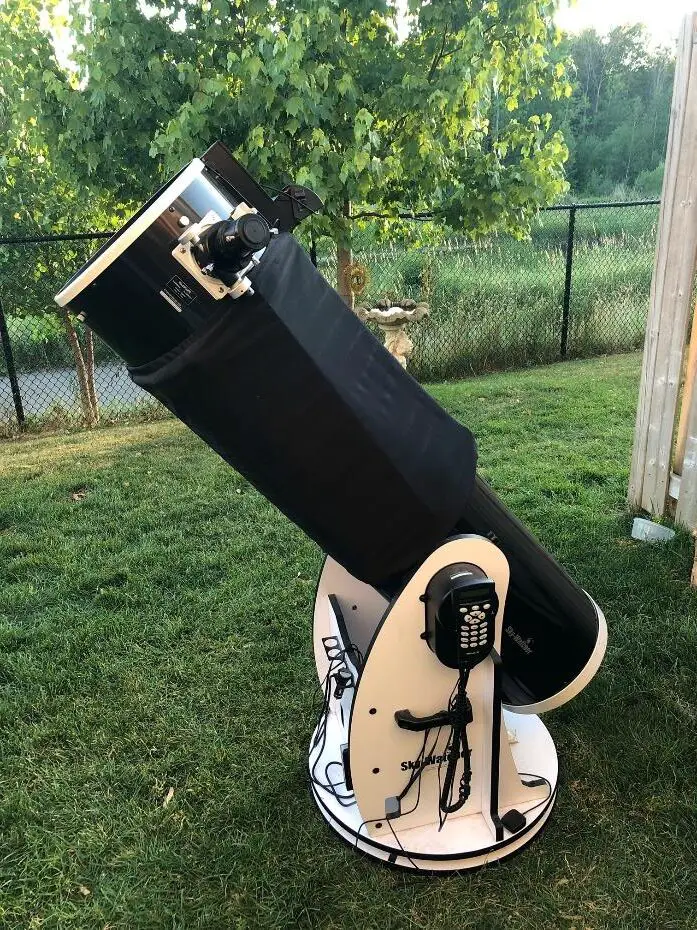An 8 Inch Dobsonian is one of the most commonly recommended telescopes for beginners.
It is often recommended because it is a high quality telescope that is very affordable and portable. You can use this telescope to see some really exciting objects.
Depending on the weather conditions, the time of year and the darkness of your sky you can expect to see:
Orion Nebula – The Orion Nebula or M42, is located in the constellation Orion 1344 light years from Earth. It contains over 1,000 stars and it is a very popular object to find and share with others when you are observing. It is a large star forming region and it is studied heavily by Astronomers because it is the closest star forming region to Earth.
To locate the Orion Nebula first find Orion’s Belt and his sword and look at the third star down and you will see it.
Once you have found it, you can use a high power eyepiece to locate the four bright stars in the center called The Trapezium. You may be able to see color if the conditions are very good and the transparency is high.
You will be tempted to take out your cell phone to grab a picture and I think you will be pretty happy with the results when you do.

Terminator on the Moon – Our closest satellite is very bright when viewed through a telescope. Observe the moon around a half moon.
You can see the terminator, the line that separates day and night on the Moon. It is interesting to see the way this affects shadows.
If you find the moon too bright to observe, try switching to higher magnification or using an inexpensive moon filter.
Rings of Saturn – You can clearly see the rings of Saturn and the Cassini Divide that is the space between the rings. Many astronomers clearly remember the first time they saw the rings of Saturn.
Jupeter and Moons – Jupiter is 8 light minutes away from us and it is one of the brightest objects in the sky, making it pretty easy to find with your new telescope.
When you are observing Jupiter look for the 4 galilean moons and the great red spot.
Jupiter rotates very quickly so you may not be able to see the red spot when you start observing, but check again throughout the night as it may come around.
Ring Nebula – Also known as M57 This planetary nebula is located near the star Vega 2283 light years away.
You will want to find the Ring Nebula with a low power eyepiece and switch to your highest useful magnification to see as much detail as possible.
The Ring Nebula looks like a little bubble, and it is probably the hardest object on this list to find, but there is nothing like it.
Try looking on a moonless night or a new moon.
Globular Cluster in Hercules – This is best known as M13, and it’s the largest globular cluster in the Northern Hemisphere it is about 22,000 light years away and composed of between half a million and a million stars.
You can find M13 in the constellation Hercules.
Find this object with low power and then increase your magnification as much as possible.
I recommend the Orion SkyQuest XT8 for a great 8 inch Dobsonian telescope. I have found Orion’s customer service to be very helpful and responsive when I have had questions.
Here is our Review of the Orion SkyQuest XT8.
If you are completely new to astronomy I recommend the AD8 because of all the accessories and things that come with the scope. Here is the complete review of the AD8.
Weather
Weather conditions play a big part in what you can see with your 8 inch Dobsonian. You may find yourself paying attention to clouds in a way you never had before!
On a clear night, with little or no moon, no clouds and high transparency you will be able to see more objects more clearly than usual.
There are several weather conditions that you will need to consider when you start observing:
- Cloud Cover
- Moon Phases
- Seeing Conditions
- Transparency
- Dew Point
There are a couple apps I recommend that help you determine if you have good observing conditions on any given night.
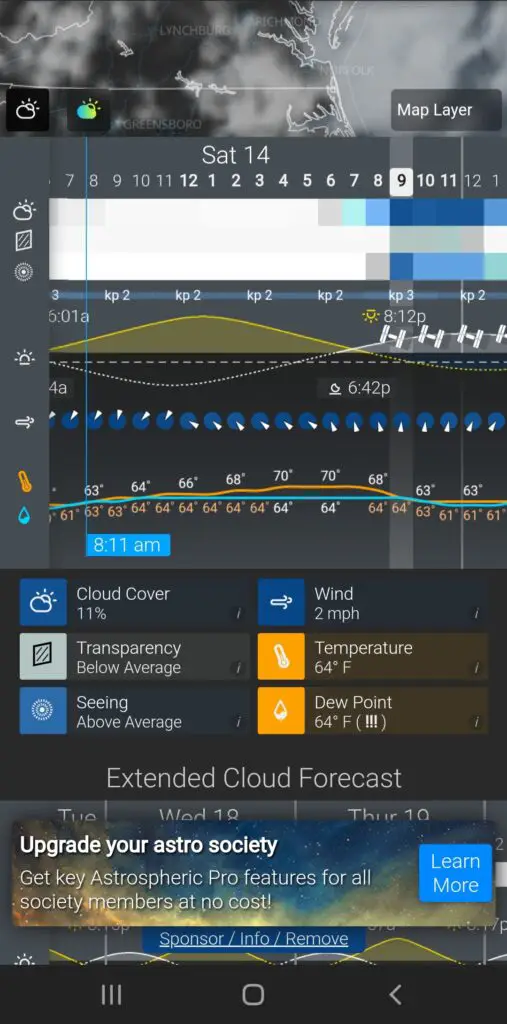
These apps are by no means 100% accurate but they help give a ballpark idea of the conditions and help you plan for your night of observation.
My favorite app is Astrospheric. You can check dew point, transparency, cloud cover and seeing. It also displays your GPS coordinates if you have a goto telescope that requires that information.
Like many things in Astronomy you may find that you learn most from trial and error.
Once I took a trip to a bortle 2 dark site and the transparency was above average and I saw a clear difference in the brightness and raw color in the orion nebula and “transparency” according to Astrospheric was above average. That night I learned that transparency is important for seeing color in nebulae.
Galaxies do not require good or excellent seeing conditions to observe as they do not require sharp focus.
When you are using a Dobsonian Telescope, the dew point is extremely important. The dew point measures the amount of water in the air and that water can gather on your mirrors. When the dew point is very close to the temperature you will start seeing dew accumulate on your eyepieces and mirrors
If your secondary mirror starts fogging up you will no longer be able to use your telescope that night.
You will also want to consider temperature.
Be sure to dress warmly for low nighttime temperatures, and plan to give your telescope time to acclimate to the ambient temperature.
You should only need about 30 minutes for an 8 inch Dobsonian to come to ambient temperature. You can read more about this process in the linked article.
If you have a cooling fan on your primary mirror, turn it on to help the scope cool down, but you may want to turn it off when actually observing because it can distort your views.
Eyepieces
The eyepieces you use will also have an impact on what you will be able to see. Your Dobsonian likely came with an eyepiece or two and those are great to get you started. You can read my exact eyepiece recommendations in this post.
Try to keep your eyepiece selection small and simple. The best ones are the ones you use!
Magnification
It may seem like the more magnification the better, but that is not always true. Ideally you want at least one low power,one mid range power,and one higher power.
Remember the higher the number on your eyepiece,the lower the magnification it will give,the lower the number,the higher magnification it will give. A 9mm will give more magnification than a 25mm.
It is important to have low magnification eyepieces so that you can find objects more easily and see large objects in one field of view.
Many of the 2 inch eyepieces that come with your telescope may be ok and comfortable enough to use.
However, you may find that the higher power eyepiece has a very small hole to look through with little eye relief and a very small field of view causing uncomfortable eye strain. High power eyepieces are generally more difficult to find. Try a few used or visit a star party to see what you like.
You may be tempted to buy eyepieces with very high magnifications, but you may not be able to use these eyepieces very often as the conditions need to be above average for them to be useful.
Where I live I only get these conditions a few times a year,but it’s nice to have one handy if the conditions arise so you can get a memorable view.
I recommend buying eyepieces used from cloudy nights,as they hold their value well, not much can go wrong with one if they are properly taken care of,and you can always resell if you decide it’s not right for you.
Buying Eyepieces
Many astronomers have a large eyepiece collection, and you may want to start building yours. Here are my best recommendations for eyepieces at every price point.
| Budget | Gold Line Svbony | 66 Degree Field of View |
| Mid Range | Explore Scientific | 82 Degree Field of View |
| Lux | Tele Vue | Delos Line |
Don’t be afraid to spend some serious money on eyepieces as they can stay with you even if you decide to upgrade your telescope. The eyepieces also sell well used and hold their value very well.
The premium eyepieces are better corrected and will show a more crisp image.
You can add a 2x barlow lens to your collection which will effectively double your eyepiece collection, just be sure to buy the correct size for your focuser (1.25” or 2”). You can read more about barlows in the linked post.
Storage
When you are out using your telescope keep your eyepieces covered with the dust caps on, in your eyepiece case when you are not using them.
This will help prevent them from getting dusty, dirty or wet with dew.
I like my Apache pluck foam case to transport my eyepieces. This hard sided case keeps the eyepieces clean, dry and protected.
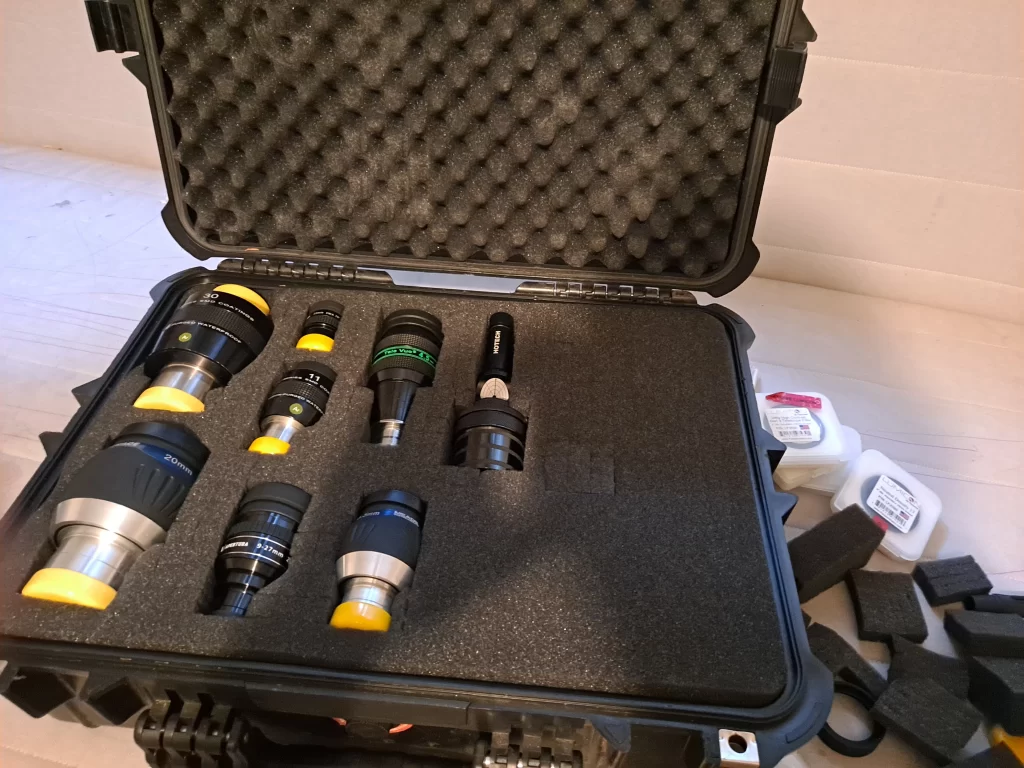
Filters
Filters are small disks that attach to eyepieces and can make images crisper by increasing the contrast.
There are quite a few types of filters that you may want to consider with your 8 inch Dobsonian.
For any lunar observing you will likely find a moon filter useful. Looking at the moon can be almost too bright to withstand without one.
In my opinion a variable polarizing filter is the best moon filter. It will allow you to manually adjust how much moonlight is dimmed, so you can determine what level of brightness is most comfortable for you.
If you live in a very light polluted area (bortle 5 or above) you may want to consider a light pollution filter.
A UHC filter is pretty much the same as a light pollution filter. It brings down the emissions caused by artificial light.
When it comes to light pollution, the astronomy community says that “The best filter is a fuel filter.” Meaning driving to a dark site is much better than adding any sort of filter to your optics.
Also, a good nebula filter such as an OIII filter can really make the Orion nebula, Dumbbell nebula, and many other nebulae really pop.
They work by not allowing certain types of light through and creating higher contrast in your image.
Light Pollution
The amount of light pollution in your area will determine what you can see and what you cannot.
Light pollution is light that is generated in your town or city that is reflected off the atmosphere that makes it difficult to see into space.
Light pollution is measured on the Bortle Scale. It can be easy to find your local Bortle Score on this Light Pollution Map.
I live in a Bortle 4 area and I enjoy observing close to home, but when I travel to a Bortle 2, I see a big difference. Traveling to dark sites is a great way to enjoy the hobby.
I find that my Dobsonian telescope is very portable and easy to transport and set up away from home.
Is a Dobsonian Telescope Portable?
One reason an 8 inch Dobsonian telescope is such a great first telescope is because it is easy to transport.
A 8 inch Dobsonian weighs approximately 50 pounds, with the weight split pretty evenly between the optical tube and the base. This makes the telescope easy for most people to transport.
My 10 inch Dobsonian fits easily in the back seat of my Honda Civic.
If you live in an area with dark skies you can also keep your Dobsonian fully assembled in a garage or shed.
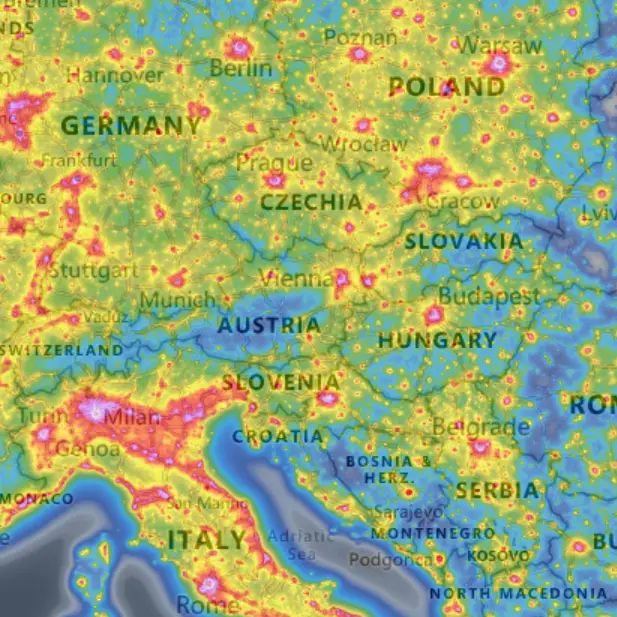
What are Dobsonian Telescopes Good For?
Dobsonians are good for visual observing, sharing the hobby, and even some astrophotography. You can see planets, galaxies, nebulae and star clusters with a Dobsonian Telescope.
These telescopes were designed by a man named John Dobson who is famous for making astronomy very accessible to hobbyists.
The simple, intuitive design is great for beginners or experienced astronomers who are looking to get a lot of aperture for little money.
You may have heard that Dobsonians are not good for photography and there is some truth to that, but I am very happy with the images that I have been able to capture with my telescope.

